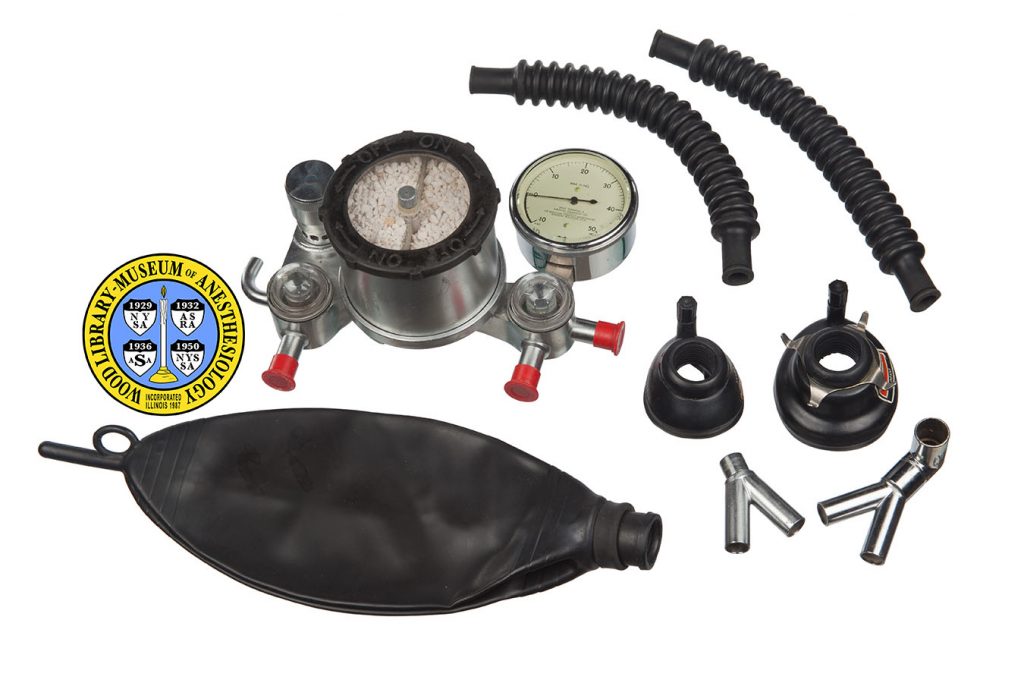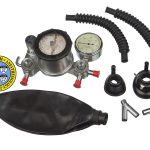Ohio Model 60 Infant Circle Absorber
The Ohio No. 60 Infant Circle Absorber, patented in 1958, was one the first anesthesia breathing systems developed in the US specifically for infants and children. To increase safety, the inventor, Wayne W. Hay, not only incorporated smaller tubing and valves, he added a pressure gauge, which was something not found in the other pediatric breathing systems at that time. Also unique was his small carbon dioxide (CO2) absorber that allowed the absorbent material to be changed while anesthesia was being administered.
Like many first generation technologies the Ohio Infant Circle Absorber was not perfect but its employment informed the design of subsequent systems and methods. Breathing systems of this generation were replaced during the 1970s with improved technology.
In a “circle” breathing system the gases literally travel in a circle through a series of tubes, connections, valves and other apparatus. This breathing system was also used as a “closed” system, allowing for total rebreathing of exhaled gases. Most American anesthesiologists were introduced to the circle breathing system in 1930 by Connecticut anesthesiologist, Brian C. Sword, M.D. (1889-1956).
Catalog Record: Ohio Model 60 Infant Circle Absorber
Access Key: akhr
Accession No.: 1981-08-21-1 A
Title: [Ohio no. 60 infant circle absorber.]
Author: Hay, Wayne W.
Corporate Author: Ohio Chemical and Surgical Equipment Company.
Title variation: Alt Title
Title: Ohio model 60 infant circle absorber.
Title variation: Alt Title
Title: Ohio infant circle absorber.
Title variation: Alt Title
Title: No. 60 Ohio-Heidbrink infant circle absorber.
Title variation: Alt Title
Title: Heidbrink infant circle absorber (model No. 60).
Publisher: Madison, Wisconsin : Ohio Chemical, [1954-1970].
Physical Descript 1 breathing system : metals, rubber, wood, leather : 33 x 26 x 15 cm.
Subject: Respiration – instrumentation.
Subject: Carbon Dioxide Absorbers.
Subject: Anesthesia, Inhalation – instrumentation.
Subject: Anesthesia, Closed-Circuit.
Note Type: General
Notes: Title taken from an early advertising pamphlet. The earliest advertisements
found (1954 and 1955) do not include the words, “No. 60”, but all later
references to the system use the terms.
Note Type: Citation
Notes: Dorsch JA, Dorsch SE. Understanding Anesthesia Equipment: Construction, Care
and Complications. Baltimore: Williams & Wilkins; 1975:215-218.
Note Type: Citation
Notes: Hay WW, inventer. Carbon dioxide absorber for anesthetic administering
apparatus. US patent 2,837,413. June 3, 1958.
Note Type: Citation
Notes: Smith RM. Progress in paediatric anaesthesia in the United States. Anesth
Hist Assoc Newsl. 1993;11(2):1-5.
Note Type: Citation
Notes: Smith RM. Equipment. Anesthesia for Infants and Children. St. Louis: C.V.
Mosby; 1959:90-94.
Note Type: Citation
Notes: Sword BC. The closed circle method of administration of gas anesthesia.
Anesth Analg. 1930;9(5):198-202.
Note Type: Physical Description
Notes: A black leather covered wood case measuring approximately 33 x 26 x 15 cm
containing various equipment of the Ohio No. 60 Infant Circle Absorber;
Included in the case are the following: Two corrugated black rubber tubes,
one 33.5 cm long, the other 24 cm long; One absorber unit measuring
approximately 17 x 24.5 x 10.5 cm; 1 extra absorber canister, 6 cm in height
and 8.5 in diameter; Two black rubber top covers for the canister, one black
rubber bottom cover, and one clear top cover; Clamp for post; One mask
connector (Y-valve); Premature anatomical masks, 1 in good condition, 2 very
dried and misshapen; One infant mask with hook ring; One connector ; One
Adams catheter connector; One hook ring ; One black rubber Guedel Foregger
oral airway.
Note Type: Acquisition
Notes: Donated to the WLM by Myron J. Levin, MD.
Note Type: Historical
Notes: The Ohio No. 60 Infant Circle Absorber, patented in 1958, was one the first
anesthesia breathing systems developed in the US specifically for infants and
children. To increase safety, the inventor, Wayne W. Hay, not only
incorporated smaller tubing and valves, he added a pressure gauge, which was
something not found in the other pediatric breathing systems at that time.
Also unique was his small carbon dioxide (CO2) absorber canister that allowed
the absorbent material to be changed while anesthesia was being administered.
Note Type: Historical
Notes: Like many first generation technologies the Ohio Infant Circle Absorber was
not perfect but its employment informed the design of subsequent systems and
methods. Breathing systems of this generation were replaced during the 1970s
with improved technology.
Note Type: Historical
Notes: In a “circle” breathing system the gases literally travel in a circle through
a series of tubes, connections, valves and other apparatus. This breathing
system was also used as a “closed” system, meaning it allowed for total
rebreathing of exhaled gases. To follow the flow of gas through one rotation
we could start where fresh anesthetic gas and oxygen, from the anesthesia
machine, is delivered to the patient via an inspiratory tube. The patient’s
exhaled breath is carried away in an expiratory tube. Next, CO2 is filtered
out of the exhaled breath by the absorber so that oxygen and anesthetic gas
not absorbed by the patient’s body can be sent back to the patient after
being mixed with fresh gas. The amount of fresh gas and oxygen that is added
only replaces what the patient’s body absorbed. Then, the rotation starts
again.
Note Type: Historical
Notes: Most American anesthesiologists were introduced to a circle breathing system
in 1930 by Connecticut anesthesiologist Brian C. Sword.
Note Type: Reproduction
Notes: Photographed by Mr. Steve Donisch on January 15, 2013.
Note Type: Exhibition
Notes: Chosen for the WLM website (noted June 10, 2013).


